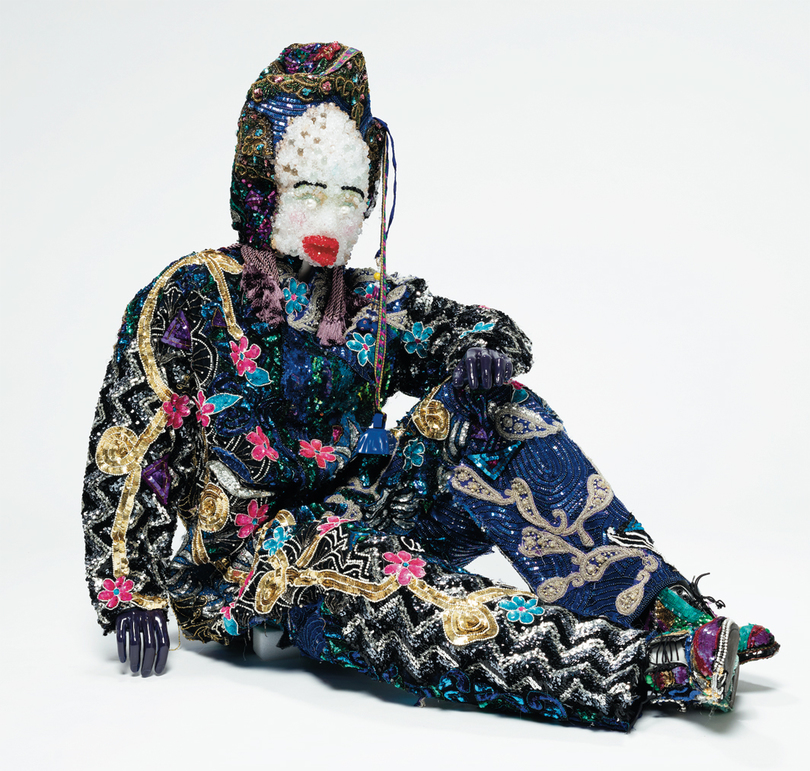
- Source: Artforum
- Author: Alpesh Kantilal Patel
- Date: April, 2021
- Format: Print
Raúl de Nieves
MUSEUM OF CONTEMPORARY ART, NORTH MIAMI

Raúl de Nieves, Fina Vision, 2019, vintage military suit, sequins, metal bells, threads, glue, cardboard, plastic beads, tape, trims, mannequin, dimensions variable.
Walking into “Eternal Return & the Obsidian Heart,” Brooklyn-based artist Raúl de Nieves’s survey exhibition here, felt like entering a carnival-like space that was part Gothic cathedral, part queer dance club. The artist, like an alchemist, transforms the mundane into the marvelous. For instance, Celestial, 2007, an early sculpture, began as a pair of high heels de Nieves wore to sundry queer and art events while living in San Diego. But after some labor-intensive glamorizing, the shoes were now barely recognizable. In encrusting them with sparkling colorful beads and pearls, the artist had not so much memorialized the footwear as he had reincarnated it into a scintillating undulating mass of orange, yellow, and transparent jewels.
The theme of rebirth also manifested in Celebration, 2020, an installation that featured a deconstructed soft sculpture of de Nieves’s mother giving birth to him. The maternal figure, adorned with beads, pearls, and a few yellow feathers, lies flat on a roughly knee-high platform. Surrounding the body is a polychromatic array of confetti, buttons, and metal bells. The woman is contorted and appears to writhe; she seems to be in a state of both glittery decomposition and revitalization. On the plinth are more identifiable objects, such as doll heads, watches, a condom, a lipstick, a crumpled Starburst package wrapper, and even the artist’s 2018 Frieze Art Fair identification badge. A more recent addition, a face mask, spoke to our current pandemic moment.
De Nieves’s roughly sixty-foot-long mural Basilio, 2019, named after the artist’s maternal grandfather, took up most of one wall within the exhibition and further illustrated his preternatural approach to materials. From afar, the mural appeared to be composed of stained glass, like a grand window inside a massive church. A closer look, however, revealed that the sixty-four-panel piece had been constructed from the most pedestrian of materials—tape, acetate paper in various colors, glitter, house paint, and wood—but to wondrous effect. At the heart of the work is an infinity sign, flanked on both sides by a host of lunar forms in different sizes—perhaps moons encircling planets, or planets orbiting the sun: a cosmic tableau of eternal return. This sense of circularity and the celestial also comes to the fore in de Nieves’s When I Look into Your Eyes I See the Sun, 2018, a functioning carousel.
Directly across from the mural was Fina, 2019, a large, ziggurat-style structure named after de Nieves’s mother. It is made from wood and black glass—the latter is a substitute for shiny obsidian, which, in ancient Mexican cultures was used as a portal mirror through which one could commune with one’s ancestors. Sitting or standing on Fina are mannequins dressed in vintage military suits. But the figures were barely recognizable, as they have been festooned with an assortment of alluring baubles and bijous. The designs for the dolls’ elaborate costumes were influenced by religious ceremonies de Nieves saw in Michoacán, Mexico, where he spent part of his youth. Monitors nearby played videos in which the artist dons these costumes for various collaborative performances with musicians. Unfortunately, this documentation failed to capture what it must feel like to witness these rituals and ceremonial objects in person—the footage, alas, mitigated the works’ singular magic.
Queer artists of color such as de Nieves interfere with the whiteness of white-cube cultural institutions in necessary numinous ways. An infectious optimism—merged with deep imagination and a generous dose of queer fabulousness—suffused this show. The artist’s presentation was like a bright discotheque illuminating a very dark world.

